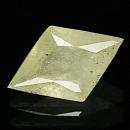|
|
||||||||||||||||
|
||||||||||||||||
|
||||||
|
|
|
|
Austinite
|
|
| | |
| Discovered in 1935; IMA status: Valid (pre-IMA; Grandfathered) | ||
|
| ||
|
Chemistry |
|
|
| |
|
CaZn(AsO4)(OH) | |
|
|
Calcium Zinc Arsenate Hydroxide |
|
Molecular Weight: |
261.39 gm |
|
Composition: |
Calcium |
15.33 % |
Ca |
21.45 % |
CaO |
|
|
Zinc |
25.02 % |
Zn |
31.14 % |
ZnO |
|
|
Arsenic |
28.66 % |
As |
43.96 % |
As2O5 |
|
|
Hydrogen |
0.39 % |
H |
3.45 % |
H2O |
|
|
Oxygen |
30.60 % |
O |
|
|
|
|
|
100.00 % |
|
100.00 % |
= TOTAL OXIDE |
|
|
|
||||
|
Classification |
|
|
| |
|
Phosphates | |
|
7/B.26-40 | |
|
|
8 : PHOSPHATES, ARSENATES, VANADATES
|
|
Related to: |
Adelite-Descloizite Group. Austinite-Conichalcite Series. The zinc analogue of Cobaltausinite and Nickelaustinite. |
|
Members of Group: |
Adelite-Descloizite Group: Adelite, Arsendescloizite, Austinite, Cechite, Cobaltaustinite, Conichalcite, Descloizite, Duftite, Gabrielsonite, Gottlobite, Hermannroseite, Mottramite, Nickelaustinite, Pyrobelonite, Tangeite |
|
Varieties: |
Cobaltoan Austinite, Cuprian Austinite |
|
Synonyms: |
Brickerite |
|
|
|
|
Crystal Data |
|
|
|
|
|
As enantiomorphous bladed crystals exhibiting {011}, {111}, {111}, {010} and several other forms, sometimes forming scepters. Also as radially fibrous crusts and nodules. |
|
|
Left- and right-handed individuals joined on (100), with (010) and (001) coincident. |
|
|
|
|
|
Physical Properties |
|
|
|
|
|
Good on {011} |
|
|
Irregular/Uneven, Conchoidal |
|
|
Brittle |
|
|
4.0 - 4.5 |
|
|
4.13 (g/cm3) |
|
|
None |
|
|
Not Radioactive |
|
|
|
|
|
Optical Properties |
|
|
|
|
|
Colorless to pale Yellowish White or bright Green; Colorless in transmitted light. |
|
|
Transparent to Translucent |
|
|
Sub-Adamantine, Silky in aggregates |
|
|
1.759 - 1.783 Biaxial ( + ) |
|
|
0.0240 |
|
|
Weak; r > v |
|
|
None |
|
|
|
|
|
Occurances |
|
|
|
|
|
Geological Setting: |
A rare secondary mineral in the oxidized zone of some arsenic-rich base-metal deposits. |
|
Common Associations: |
Adamite, Limonite, Quartz, Talmessite (Gold Hill, Utah, USA) |
|
Common Impurities: |
None |
|
Type Locality: |
Gold Hill Mine (Western Utah Mine), Gold Hill, Gold Hill District (Clifton District), Deep Creek Mts, Tooele County, Utah, USA |
|
Year Discovered: |
1935 |
|
View mineral photos: | |
|
|
|
|
More Information |
|
|
|
|
|
| |
|
|
|
|
Austinite
is found in just a handful of localities. In the USA,
at the Type Locality in the Western Utah mine, Gold
Hill, Tooele County, Utah; at the Mohawk mine, Clark
Mountains, San Bernardino County, California; from
the Table Mountain mine, Galiuro Mountains, Pinal County, Arizona;
at Sterling Hill, Ogdensburg, Sussex County, New
Jersey; in the Tuckerís tunnel uranium deposit, near
Durango, Hinsdale County, Colorado. From the Ojuela
mine, Mapimi, Durango, Mexico. At the Lili mine, near
Lomitos, Bolivia. From the Kamariza mine, Laurium, Greece.
At Tsumeb and Guchab, Otavi district, Namibia. In the
Puttapa zinc mine, near Beltana, South Australia. |
|
|
We
have not photographed our Austinite gems
yet. Please
check back soon. |
